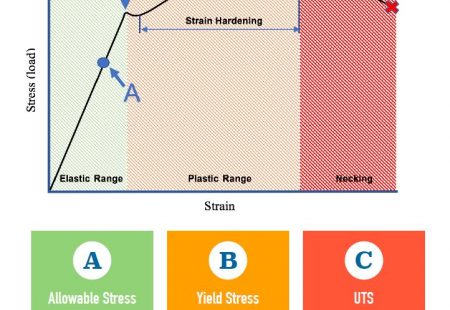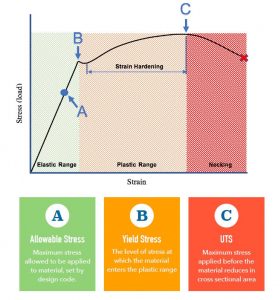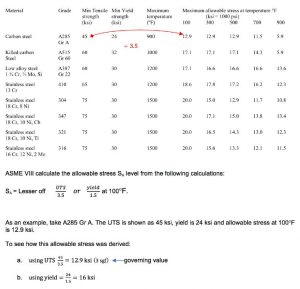- Home
- About
- Training Courses
- ASME Courses
- API Courses
- API 510 Pressure Vessel
- API 570 Process Pipework
- API 653 Aboveground Storage Tank
- API 936 Refractory Personnel
- API 580 RBI Online
- API 580 RBI Classroom *New*
- API 571 Corrosion & Materials Online
- API 571 Corrosion & Materials Classroom *New*
- API 577 Welding Inspection & Metallurgy Online
- API 510 CPD Training
- API 570 CPD Training
- API 1169 Pipeline Construction
- API SIFE Source Inspector Fixed Equipment
- API SIRE Source Inspector Rotating Equipment
- E-Learning
- Technical Courses
- API CPD Recertification
- Training Courses
- Technical Hub
- Virtual Training
- FAQs
- Contact
- Online Training Portal
- Shop

- In: Training | On: Feb 4, 2021
Don’t Stress It!
Allowable Stress – What’s it all about? Find out here.
The tensile test is used to establish the tensile strength of steel. If a tensile force is applied to a steel bar it will have some extension. Up to the yield point, stress and strain will remain proportional, signified by the straight line in Fig. 1.
Not all steels have a defined yield point, so there is another method for establishing the ‘theoretical’ yield which we will cover in the next article.
Removal of the load during this phase will cause the material to retract to the original length. This is known as the elastic range (think of an elastic band, if you pull it and let go it returns to its original size).
The point where plastic deformation occurs is the yield point (point B). If the load is removed after this point, the specimen it will not revert back to the original length and is said to have plastically deformed. Think of
plasticine, once elongated, it does not revert back to the original length.
In engineering terms, yielding the material is often referred to as a failure (don’t confuse this with a loss of containment failure). There are occasions where the material will be taken past this point to achieve certain mechanical properties, such as strain hardening.
In Fig. 1, between point B and C, the material is actually strain hardening (getting stronger because of dislocation movements within the crystal structure of the material). At point C (UTS), the material will begin to neck and elongate further until fracture.

We wouldn’t want to operate the component close to the yield point, an unexpected event (over pressurisation) or similar could yield the material. There must be a factor of safety involved and this is effectively what allowable stress is – a maximum permissible stress level the material can be exposed to so as to be in compliance with the code.
In ASME II-part D or ASME B31.3 for example, you are lucky enough to be provided with allowable stress tables. To find the allowable stress it’s simply a matter of locating your material and importantly the grade then reading of the allowable
stress value depending on the design temperature (watch out – sometimes nominal thicknesses come into play too).
You will notice that the allowable stress decreases as the temperature increases due to the weakening of the material.
Some allowable stresses are shown below, taken From Sec. II Part D

Different designed codes use different factors of safety. For ASME VIII Div 1. as shown above, its UTS/3.5 or Yield/1.5. There are other ratios that are used for things like austenitic stainless steels on occasion, but this is a simplified explanation.
Don’t mix the codes as we have seen before. Each has varying ratios, ASME B31.3 for example generally uses UTS/3 or Yield/1.5.
Two points to note:
1) Make sure you use the correct temperature
2) Make sure you use the correct grade
If you want to find out more about our training, contact us:


